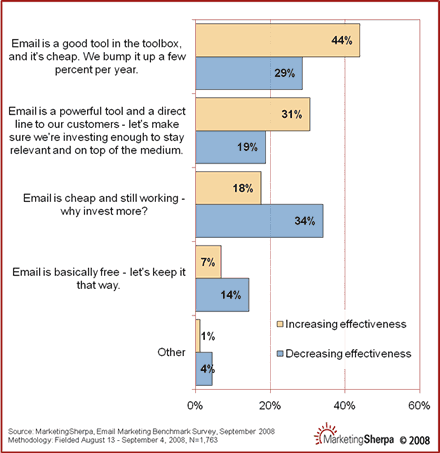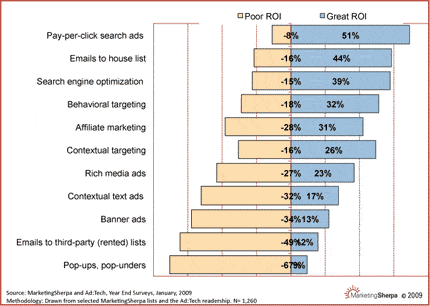Would you believe that e-mail marketing is still in its infancy?
A couple of graphs from MarketingSherpa drive an important point home about the use of e-mail for marketing. It works, it has always worked, and it will continue to work. You just have to know how to use it.
In this graph, “Emailing to house lists” falls behind “Pay-per-click search ads.” However, since fewer marketers are reducing the use of house list email, it should be #1.
I’ll go so far as to state this:
If you don’t have your email marketing efforts nailed, you have no business investing in social marketing.
Social marketing has its place, and is not a fad. But, we know so much about good, permission-based email marketing, that it is criminal to ignore it. Don’t let email superstitions drive your marketing strategy.

The more sophisticated a marketer you are, the more likely you are to use house list email marketing.
MarketingSherpa has some choice interpretations of this graph:
Those that see the effectiveness of their email programs diminishing are much more likely to have short-sighted organizational attitudes toward the tactic.
Organizations with investment-oriented views of email reap the rewards. They have higher open, click and conversion rates. In addition, they are much more likely to have a metrics-based grasp of how email works for them. Those with the “email is free” view, on the other hand, are more likely to fall into the group that doesn’t track conversion.
It is so easy to measure email’s effectiveness, that I would argue that you can’t call yourself a marketer if you’re not watching your results. We call you a spammer.
You’re not marketing if your not measuring.
Essential for any Considered Purchase
If all of your customers buy spontaneously on their first visit and never buy again, then you may not need to invest in email marketing. I don’t know of any business like this.
If your customers take weeks or months to come to a purchase decision, you cannot ignore email. Email is the biggest social network on the planet. Even retirees use email.
Your House List is the list of people who have given you permission to enter their inbox. This means they want what you have, and should be given every opportunity to opt out.
Email Isn’t Promotional, It’s Social
Don’t use email purely to promote sales and discounts. Use it to educate, inform and entertain. If you have a blog, send your most interesting posts via email. Most of us aren’t using RSS. Email is your ticket to growing your blog readership.
Then simply advertise in your own emails.
It’s Time to Get Your Email On: Get Started Now
It does take time to build your house list, so start now. Email can be fun if you’re sending content that reflects your passion for your company, your industry and your brand.
Then you can start investing in the smaller, less intimate social networks out there.














